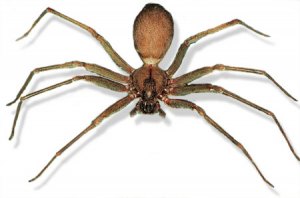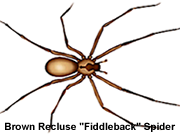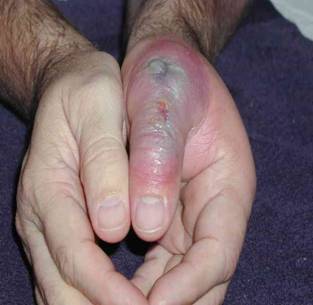

Brown Recluse Spider
location, identification, behavior, poison, bites treatment and first aid


location, identification, behavior, poison, bites treatment and first aid
The bite of a brown recluse spider can cause little but permanent skin damage. In most cases it can cause tissue destruction that ranges from moderate to severe damage. The severity of the bite and its damage can only be assessed after a few days have passed after the event. It may take several months before the bite can completely heal.
The bite of this spider develops slowly and takes up to 12 hours before it shows itself as a bite mark. Death of the body's skin, also known as necrosis, can happen within 96 hours of the bite. If there are no necrosis that happened within this time period, the bite will not most likely to harm the victim any worse.
Necrotic lesions caused by a brown recluse spider are hard to manage. It may take early surgery to be able to remove the dead tissue and to improve skin appearance. Necrotic lesions should be cleaned thoroughly and mature until its stop spreading and begin to heal. An area around the tissue will be removed and then skin grafting can be ensued once all signs of skin necrosis have gone.
There are basically 2 types of poison cycles related to the brown recluse spider bite. It can either be a skin loxoscelim or skin visceral.

Skin loxoscelism, which happens 85% of the time in spider bite victims, turns the bite on the skin to necrotica plaque which manifests the common symptoms of a spider bite as mentioned above. During this cycle, the life of the victim is not threatened but will leave the skin with scars caused by the poison penetrating the skin's small vessels.
On the other hand, skin visceral manifests general symptoms of a spider bite along with high temperature and signs of blood in urine. When this happens, the victim may have possibly acquired a kidney insufficiency that can progress to multiorganic insufficiency. When this happens, the toxin action in the kidney and red corpuscles can eventually lead to death.
What causes a skin loxoscelim or skin visceral cycle in a victim of a spider bite? This remains unclear till this date. The susceptibility of a person basically depends on his immune system and his reactions to the bite. What remain as a certainty is that the cycles and symptoms are reported to be more serious in cases where children are the victims of the bite. Third age people and young adults are also in more danger when bitten with this type of spider.